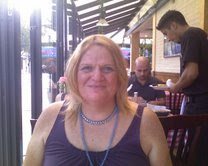In yesterday's post, I started to describe some of the ways in which spending so much time and effort on "passing" has harmed trans people individually, and as a community. I talked mainly about the ways in which it has held us back from gains other people, such as African-Americans, cis women and gay men, realized from the Civil Rights movement.
Now I want to mention some of the ways in which society's demand to pass (which is also turned against us) helped to create a Lost Generation of Transgender People.
When I was younger I, of course, read everything I could find about Christine Jorgensen. At that time, she was one of only two transgenders (the other being Renee Richards) of whom I'd even heard. In my reading, I stumbled over the newspaper headlines and stories about her. "Ex-GI Becomes Blonde Beauty", screamed the New York Daily News headline. Others were more salacious, or simply more vicious. They all, however, seemed to focus on her resemblance to Marilyn Monroe and other blonde movie stars of the time.
What I have said, and will say about Ms. Jorgensen and her role in the history of transgender people is in no way meant to disparage her. She was indeed a beautiful woman. More to the point, though, she was also a very intelligent, talented woman who took great pains to educate herself, and always exuded dignity and class. On the other hand, she fit into every notion of womanhood that prevailed in 1950's America. It was a time, of course, when the standards of beauty and glamor were almost always blonde and blue-eyed. They also had hourglass figures with impossibly small waists. Jorgensen fit that image to a "T".
What's more, though, she declared herself as attracted only to men--and, in fact, married one. And, although she worked as a photographer before her surgery, she wanted to settle into a quiet life as a housewife. Perversely, the very same sorts of people who would have demanded that she, or any other woman, lead such a life were the same people who "outed" her and kept her story in the public eye, to the point that she almost had to become the entertainer she would be for much of her adult life.
In other words, people accepted, or at least tolerated, Christine Jorgensen--who was probably the first transsexual of whom most of them had even heard--in wholly heterosexist terms. Some of those people may have been perfectly well-meaning; they may have "wanted to do the right thing" but had little to no understanding of what it meant to be transgendered or transsexual. However, their understanding--and the way Ms. Jorgensen had to conform to it, whether or not she waned to--gave people a very limited way of understanding, not only transgender people, but of their own gender and sexuality.
As I write this, I finally realize why the alliance--however tense and strained it may be--between trans people and lesbians and gays is not only beneficial, but necessary. Trans people will never have equal rights, let aloneopportunities, as long as there is so much pressure to confirm to traditional roles of one gender or the other.
In some people, this understanding of gender and sexuality, as well as their expectation that trans women would conform to "traditional" female roles, were really just very thinly-veiled homophobia.
So, three decades after Christine Jorgensen became a "blonde beauty", the pressure to "pass" was even greater than it was at the time she started her transition. The AIDS epidemic had, by that time, exploded in Castro, The Village and other gay communities throughout the United States. During that time, right-wing talk radio and other media grew exponentially in popularity. They famously advocated quarantining gay men, or even killing them: One commentator went so far as to compare gay men to the rats that carried the fleas that caused the Black Death.
In such an atmosphere, the pressure to "pass" must have greatly intensified. Who would want anyone else to know that he or she had been, at any time in her life, a man--let alone a gay one.
Having such heterosexist (and,I might add, Eurocentric) ideas about gender meant that only trans people who looked like Barbie dolls would be approved for hormones or the surgery. It also meant that only those who met such standards would have any hope of affording it--or of marrying someone who could support her after she became a "traditional" housewife.
The conditions I've described had much to do with the Lost Generation of Transgender people, and how people (including cis ones) continued to hold onto their notions of gender and sexuality,and teach them. So, during my first year of living as a woman, a prof who knew I was going through my transformation said I was "the last person she expected" to be trans because I had expressed interest in women--including her.
I wonder how many trans people gave up on their dream of transitioning as a result of what I've described---or, how many people delayed their dream, or simply gave up on it altogether. And I wonder how many were beaten, killed or simply demonized because they were thought to be one of the vectors of disease--or because they simply didn't fit into feminist organization, let alone the white heterosexual organizations they represstn.
I wonder how many trans people gave up on their dream of transitioning as a result of what I've described---or, how many people delayed their dream, or simply gave up on it altogether. And I wonder how many were beaten, killed or simply demonized because they were thought to be one of the vectors of disease--or because they simply didn't fit into feminist organization, let alone the white heterosexual organizations they represstn.









